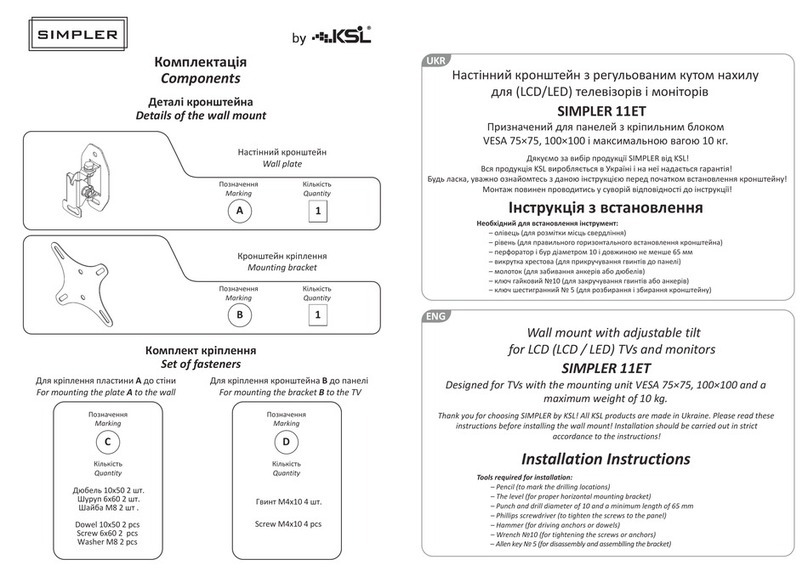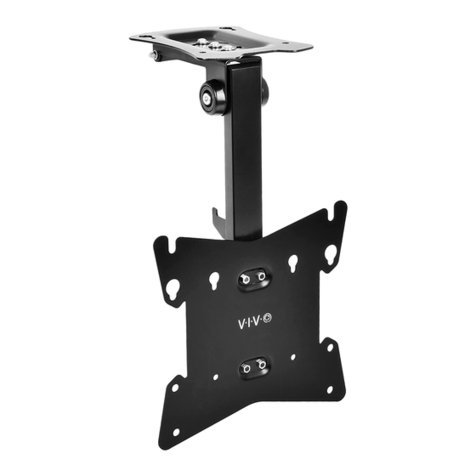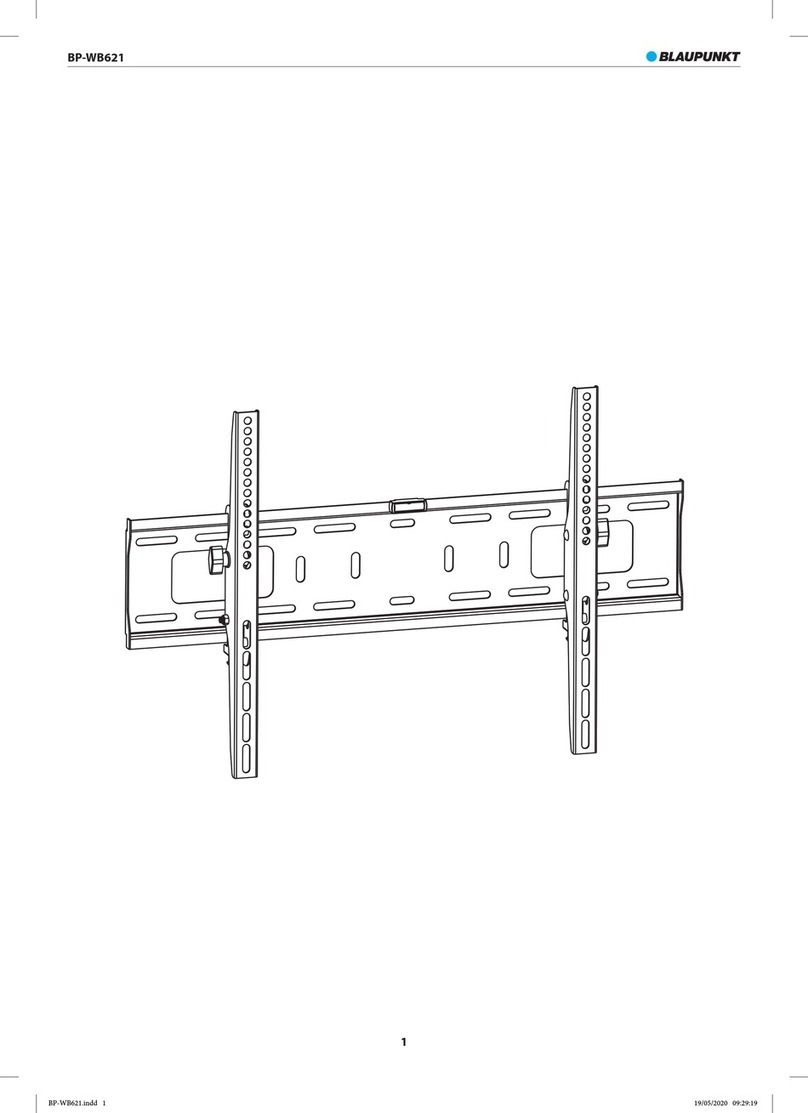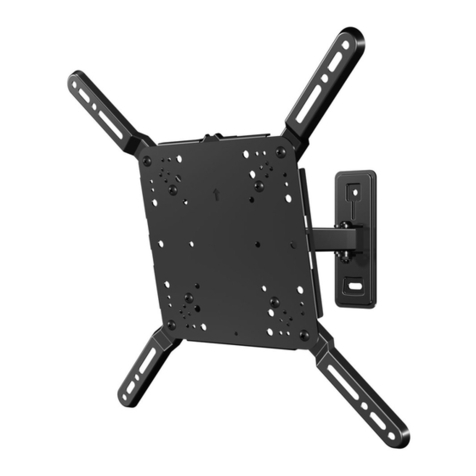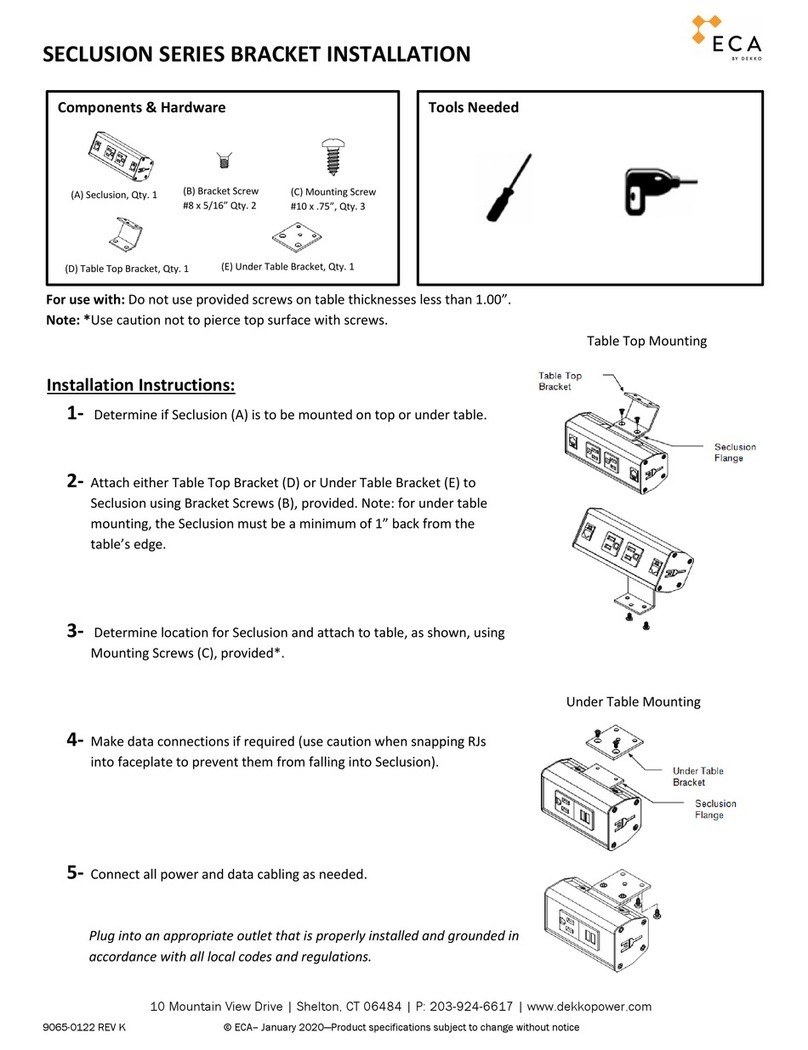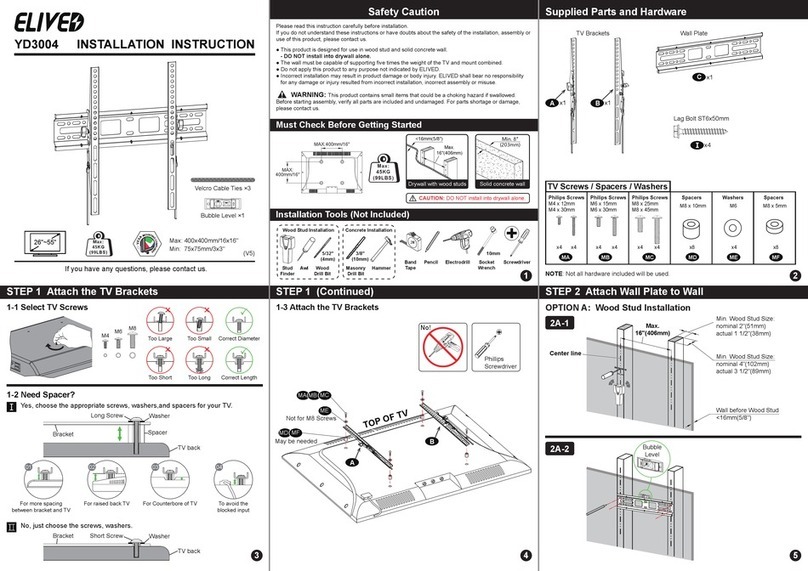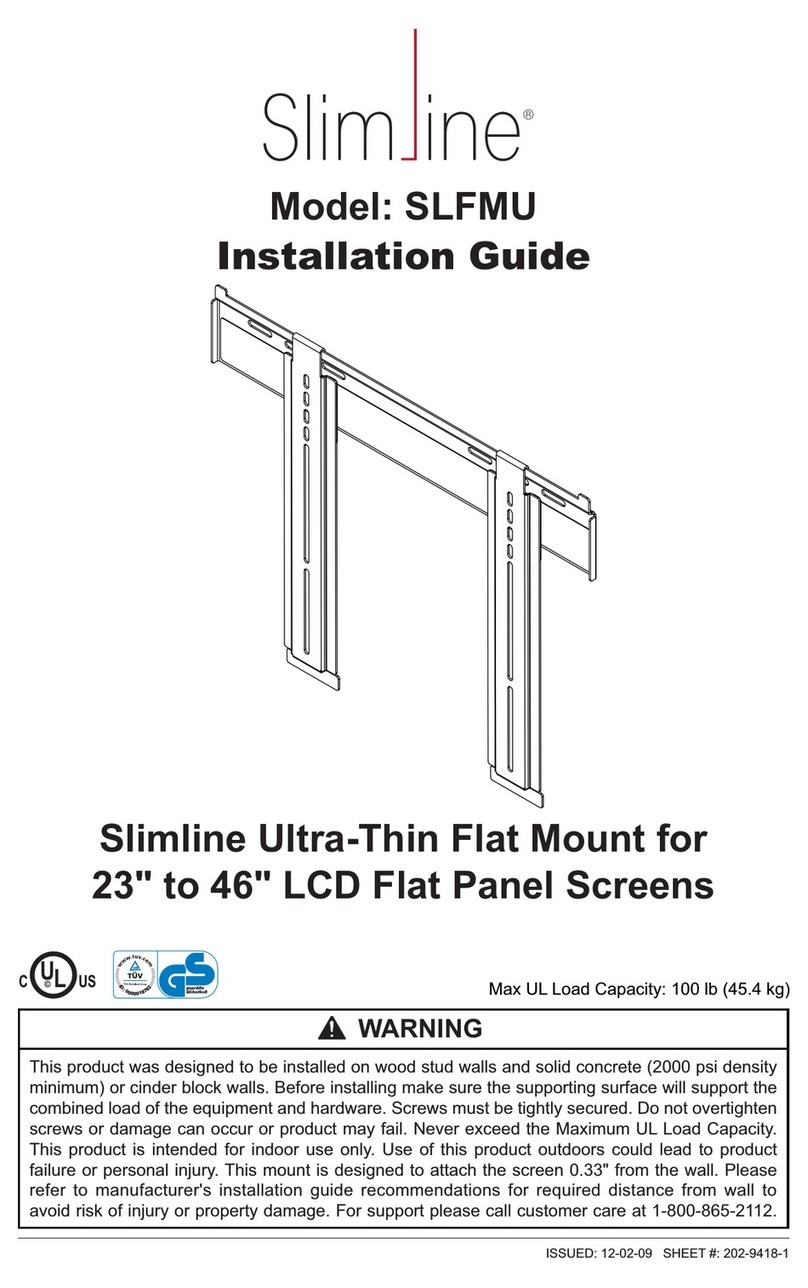Tractel Blocfor Installation guide

PT
NO
SE
FI
DK
PL
EN
FR
DE
NL
ES
IT
Acessórios Tractel®para o Davitrac Tractel®
Tractel®-tilbehør for Tractel®Davitrac
Tractel®-tillbehör för Tractel®Davitrac
Tractel®Davitract -laitteen Tractel®-lisälaitteet
Tractel®-tilbehør til Tractel®Davitrac
Akcesoria Tractel®do Davitrac Tractel®
Blocfor™, Carol™ and Scafor™ brackets for Davitrac
Tractel®accessories for the Tractel®Davitrac
Accessoires Tractel®pour le Davitrac Tractel®
Tractel®-Zubehör für Tractel®Davitrac
Tractel®-accessoires voor de Tractel®-Davitrac
Accesorios Tractel®para el Davitrac Tractel®
Accessori Tractel®per Davitrac Tractel®
Installation, operating and maintenance manual English Original manual EN
Manuel d'installation d'emploi et d'entretien Français Traduction de la notice originale FR
Installations-, Gebrauchs- und
Wartungsanleitung Deutsch Übersetzung der Originalanleitung DE
Handleiding voor installatie, gebruik en
onderhoud Nederlands Vertaling van de oorspronkelijke handleiding NL
Manual de instalación, de utilización y de
mantenimiento Español Traducción del manual original ES
Manuale dʼinstallazione, dʼimpiego e di
manutenzione Italiano Traduzione del manuale originale IT
Manual de instalação, de uso e de manutenção Português Tradução do manual original PT
Installasjons-, bruks- og vedlikeholdshåndbok Norsk Oversettelse av originalanvisning NO
Installations-, bruks- och underhållsanvisning
Svenska Översättning av originalbruksanvisningen SE
Asennus-, käyttö- ja huoltokäsikirja Suomi Alkuperäisen ohjeen käännös FI
Manual for installation, brug og vedligeholdelse Dansk Oversættelse af den originale manuall DK
Instrukcja instalacji, użytkowania i konserwacji Polski Tłumaczenie oryginalnej instrukcji obsługi PL

2
Fig. 1
Fig. 2

3
Fig. 3a Fig. 3cFig. 3b
FIG 4.a
FIG 4.b
FIG 4.c

4
FIG 5
Fig. 6a Fig. 6cFig. 6b

5
EN
Table of contents
1. Important instructions ..............................................6
2. Denitions and pictograms ......................................6
2.1. Denitions.......................................................6
2.2. Pictograms......................................................7
3. Operating conditions................................................7
3.1. Checks before use..........................................7
3.1.1. Blocfor™ 20R and 30R..........................8
4. Functions and descriptions......................................8
4.1. Blocfor™ 20R and 30R...................................8
4.2. Carol™............................................................8
4.2.1. Carol™ R...............................................8
4.2.2. Carol™ TS.............................................9
4.2.3. Carol™ MO............................................9
4.3. Scafor™ R ......................................................9
5. Installation ...............................................................9
5.1. Blocfor™ 20R and 30R...................................9
5.1.1. Installation of the Blocfor™ 20R and
30R on the Blocfor™ Davitrac bracket ..9
5.1.2. Installation of the Blocfor™ Davitrac
bracket on the mast of the Davitrac.....10
5.1.3. Dismantling of the Blocfor™ bracket
from the Davitrac mast ........................10
5.2. Carol™..........................................................10
5.2.1. Installation of Carol™ winches on
the Carol™ Davitrac bracket ...............10
5.2.2. Installation of the Carol™ Davitrac
bracket on the mast of the Davitrac.....10
5.2.3. Dismantling of the Carol™ Davitrac
bracket.................................................10
5.3. Scafor™ R ....................................................10
5.3.1. Installation of the Scafor™ R winch
on the Scafor™ Davitrac bracket.........10
5.3.2. Installation of the Scafor™ Davitrac
bracket on the mast of the Davitrac.....10
5.3.3. Dismantling of the Scafor™ R
Davitrac bracket................................... 11
6. Use ....................................................................... 11
6.1. Blocfor™ 20R and 30R................................. 11
6.1.1. Rescue operation with Blocfor™ R...... 11
6.1.1.1. Activating the recovery
function.................................. 11
6.1.1.2. Return to the fall arrest
function.................................. 11
6.2. Carol™..........................................................12
6.2.1. Carol™ R.............................................12
6.2.1.1. Rescue operation with the
Carol™ R winch ....................12
6.2.1.2. Load lifting operation .............. 12
6.2.2. Carol™ TS...........................................12
6.2.3. Carol™ MO..........................................12
6.3. Scafor™ R ....................................................12
7. Prohibited use........................................................12
8. Associated equipment ........................................... 12
8.1. PPE...............................................................12
8.2. Lifting ...........................................................13
9. Transport and storage .......................................... 13
10. Equipment compliance ........................................13
11. Marking................................................................13
12. Periodic inspection and repair .............................13
12.1. Checking the cable .....................................14
12.1.1. Composition of the cable .....................14
12.1.2. Checking the general condition of
the cable ..............................................14
12.2. Checking the Blocfor™ R ...........................14
12.2.1. Checking the marking..........................14
12.2.2. Checking the compulsory
components are present......................14
12.2.3. Checking the general condition of
the fall arrest .......................................15
12.2.4. Checking the general condition of
the cable .............................................15
12.2.5. Checking the general condition of
the tear-o energy absorber ...............15
12.2.6. Checking the fall arrest function .......... 15
12.2.7. Checking the rescue lifting system ......15
12.3. Checking the Carol™ R, Carol™ TS
and Carol™ MO winches............................ 15
12.3.1. Checking the marking..........................15
12.3.2. Checking the compulsory
components are present......................16
12.3.3. Checking the general condition of
the Carol™ winch ...............................16
12.3.4. For the Carol™ MO ............................. 16
12.3.5. Checking the general condition of
the cable ..............................................16
12.3.6. Checking the proper functioning of
the Carol™ winch ................................16
12.3.6.1. Additional check for the
Carol MO...............................16
12.4. Checking the Scafor™ R ............................16
12.5. Checking the Blocfor™, Carol™ and
Scafor™ brackets .......................................16
12.5.1. Checking the marking..........................17
12.5.2. Checking the compulsory components
are present ..........................................17

6
EN
12.5.3. Checking the general condition of
the bracket...........................................17
13. Service life........................................................... 17
14. Disposal...............................................................17
10. The operator must be physically and mentally t
when using this product. If in doubt, check with
your doctor or your occupational doctor. Pregnant
women may not use this product.
11. This product should not be used beyond its limits or
in any situation other than for its intended use. (See
chapter 4, Functions and descriptions.)
12. Before each use of a fall-arrest system, check that
there is enough fall clearance and that there are no
obstacles in the path of the fall.
13. A full body harness in accordance with EN 361 is
the only equipment around the body that may be
used in a fall-arrest system; secure it to the point
marked A on the harness.
14. It is essential for operator safety that the device or
anchor point is correctly positioned and that work
is carried out so as to minimise the risk of falls and
the height.
15. For the operator’s safety, if the product is re-
sold outside the initial destination country, the
distributor must supply: an instruction manual and
maintenance instructions for periodic inspections
and repairs, all written in the language of the
product’s country of use.
16. In addition to fall protection equipment, it is essential
for the safety of the operator and supervisor that
they use personal protective equipment such as
helmets, safety glasses, gloves and safety shoes
when handling and using this product.
17. The product may only be used with the associated
equipment described in this manual. (See chapter
8, Associated equipment.)
18. This product may only be used in the presence of at
least two operators.
19. Do not use more than two associated pieces of
equipment on the product at the same time.
20. Danger While using several pieces of equipment
where the safety function of one may aect or
interfere with the safety function of another.
21. Before use, the supervisor and operator must read
and understand the information in the EN 1496 and
EN 360 device manuals, the permanent bases for
Davitrac and davimast manual and Davitrac manual.
NOTE:
For any special application, contact Tractel®.
2. Denitions and pictograms
2.1. Denitions
“System”: This refers in this manual to the fall arresters
or winches which is attached to their Davitrac bracket.
1. Important instructions
1. Before using the product, it is essential that the
supervisor and operator review and understand
the information in the manual provided by Tractel
SAS, in order to ensure safe and eective use of the
equipment. This manual must be made available at
all times to all operators. Additional copies can be
obtained on request from Tractel®.
2. Before using this safety equipment, it is essential
that users are trained in its use. Check the condition
of the product and associated equipment and
ensure there is enough fall clearance.
3. The product may only be used by trained and skilled
operators or by operators under the oversight of a
supervisor.
4. The product must not be used and must be checked
by Tractel SAS or by an authorised and qualied
technician who must authorise in writing the re-
commissioning of the product if:
• It is not in a visibly good condition;
• There are concerns about how safe it is;
• It has been used to arrest a fall; or
• It has not undergone a periodic inspection over
the past 12 months; user safety depends on
keeping the equipment eective and strong.
5. A visual inspection is recommended before each
use; the operator must make sure that each
component is in good working order, in particular by
inspecting the condition and presence of the mast
rotation ring on the mast. When it is put in place,
the safety functions must not be deteriorated in any
way.
6. No modications or additions may be made without
the prior written consent of Tractel SAS. The
equipment must be transported and stored in its
original packaging.
7. If the weight of the operator plus that of their
equipment is between 100 kg and 150 kg, it is
essential to make sure that the total weight does not
exceed the safe working load of each component of
the fall-arrest system.
8. This product may be used in temperatures ranging
from -35°C to +60°C.
9. Comply with locally applicable occupational
regulations.

7
EN
“Supervisor”: The individual or department responsible
for the management and safe use of the product
described in the manual.
“Technician”: A qualied person responsible for the
maintenance operations described in the manual, who
is qualied and familiar with the product.
“Operator”: The person using the product as
intended.
“PPE”: Personal protective equipment against falls from
height.
“Connector”: The element connecting the components
of a fall-arrest system. It is EN 362-compliant.
“Fall-arrest harness”: The device worn around the
body for fall protection. It consists of straps and buckles.
It features fall protection attachment points marked with
an A if they may be used alone, or marked with A/2 if
they are to be used in combination with another A/2
point. It is EN 361-compliant.
“Self-retracting fall protection”: The fall-arrest
device with an automatic locking function and a
self-tensioning and retraction system for the self-
retractable lanyard.
“Self-retracting lanyard”: The connecting element of a
self-retracting fall protection system. It may be made of
a metal cable, strapping or synthetic bre depending on
the type of device.
“Maximum operator weight”: The maximum weight of
the clothed operator, wearing PPE and workwear and
carrying the tools and parts required for a job.
“Working load limit”: The limit working load of an
equipment lifting device.
“Fall-arrest system”: Set of the following items:
• An anchor device;
• A linking component;
• Fall protection in accordance with the standard
EN 363; and
• A fall-arrest harness.
“ Elevation rescue device EN 1496 class B”: A
component or subassembly of rescue equipment
allowing an operator to be winched with the help of a
rescuer from a low point to a high point and equipped
with an additional manually operated lowering function
to lower the operator over a distance of up to 2 m.
“ Rescue equipment”: The personal fall protection
system by which a person can save himself or others,
so that any fall is prevented.
2.2. Pictograms
DANGER: When placed at the beginning of a
paragraph, indicates instructions for avoiding injuries
to operators, particularly fatal, serious or minor injuries,
and damage to the environment.
IMPORTANT: Placed at the beginning of a
paragraph, indicates instructions intended to avoid
a fault in or damage to equipment, but not directly
endangering the life or health of the operator or that
of others, and/or unlikely to cause damage to the
environment.
NOTE: When placed at the beginning of a
paragraph, indicates instructions for ensuring the
eectiveness or convenience of installation, use or
maintenance operations.
3. Operating conditions
3.1. Checks before use
DANGER: Before any installation work, the
installer must have these instructions available.
Before installing a system on the Davitrac bracket
• The product marking must be present and legible.
• Before each use, make sure that the product is in
a visibly good condition, free from marks, impacts
or deformation. If not, do not use it and inform the
supervisor.
• For PPE systems, check that the system (Blocfor™
20R and 30R) is correctly attached to its Blocfor™
Davitrac bracket.
• For lifting rescue devices, check that the system
(Carol™ R 250 20 m and 30 m, Scafor™ R 500,
Blocfor™ 20R and 30R) is correctly attached to its
dedicated Davitrac bracket.
• For lifting systems, check that the system (Carol™ TS
or MO) is correctly attached to the Carol™ Davitrac
bracket.
• Before performing the work, the installer must
arrange the site so that installation work is carried
out under the required safety conditions, specically
in accordance with occupational regulations. He
must use the collective and/or personal protective
equipment required for that purpose.
After installing a system on the Davitrac bracket
• Check that the Davitrac bracket with its system is
correctly attached to the Davitrac mast with the pins
and locking pins that are xed in place on the bracket
with a cablet.
• Check that the system cables are routed correctly
above the guide pulleys without crossing each other.

8
EN
• Check that the PPE system cables are routed above
the pulley identied as PPE (g. 2) and that cables
for lifting or moving the operator are routed above the
pulley identied as lifting (g. 2). These pulleys are
positioned on the anchor head of the Davitrac.
• For information on how to use the systems, see the
operating instructions supplied with the system.
• Always check before use that:
• The cable shows no signs of abrasion, fraying,
burns or cuts; and
• The cable shows no signs of bending, abrasion,
corrosion or cut wires.
3.1.1. Blocfor™ 20R and 30R
• Check the condition of the entire length of the lanyard;
the metal cable must not show any signs of bending,
abrasion, corrosion or cut wires.
• Check that the lanyard locks when its end is pulled
quickly and that it rolls up and unwinds normally over
its entire length.
• Check the condition of the housing (no distortion,
screws present, etc.).
• Check the condition and function of the connectors:
no visible distortion, can be opened, closed and
locked.
• Check the condition of the associated components
harness and connectors. Refer to the specic
instructions for each product.
• Check the whole fall-arrest system.
• Check that the bracket is locked properly on the
Davitrac mast.
• Check that the equipment is in automatic fall arrest
function: the recovery function should not be engaged
before use.
• Check that the recovery function engages and
disengages properly.
• Check that the lanyard locks when its end is pulled
quickly and that it rolls up and unwinds normally over
its entire length.
4. Functions and descriptions
IMPORTANT: The Davitrac brackets are
intended for a specic system for exclusive use on
the Tractel® Davitrac.
• The Blocfor™ Davitrac bracket may only be used
as an anchor point with the Blocfor™ 20R or 30R
in line with the standard EN 360.
• The Blocfor™, Carol™ and Scafor™ Davitrac
brackets may only be used as anchor points
respectively with the lifting rescue devices
Blocfor™ 20R and 30R, Carol™ R and Scafor™ R
in accordance with the standard EN 1496.
• The Carol™ and Scafor™ Davitrac brackets may
only be used as anchor points respectively with
the working devices for rope access Carol™ R,
Carol™ MO and Scafor™ R in accordance with
the requirements of Directive 2001/45/EC.
• The Carol™ and Scafor™ Davitrac brackets may
only be used as anchor points respectively with
the load lifting systems Carol™ TS 500 Carol™
MO and Scafor™ R in accordance with the
requirements of Directive 2006/42/EC. In this
case, the maximum WLL is 500 kg for Carol™
TS 500 and Carol™ MO and 400 kg for Scafor™
for load lifting.
NOTE:
When the Davitrac is used to lift a load, it is strictly
forbidden to use it simultaneously as a PPE
anchor point. In this conguration, an independent
fall-arrester anchor point must secure the operator.
4.1. Blocfor™ 20R and 30R
The Blocfor™ 20R and 30R fall arrester is a self-
retracting fall arrester in accordance with EN 360; see
section 4 of the enclosed Blocfor™ ESD - EN 360
manual.
• The Blocfor™ 20R and 30R with a cable made of
galvanised steel is tested to ensure it can hold the
weight of an operator equipped with his tools and
equipment up to 150 kg.
• The Blocfor™ Davitrac bracket is tested to ensure it
can hold the weight of an operator equipped with his
tools and equipment up to 150 kg.
It is equipped with a rescue device by lifting up or
down (EN 1496 class B): recovery function allowing
the rescuer to lift and/or lower the operator after a
fall. It is used vertically when installed on the Davitrac
bracket.
This device is disengaged when the Blocfor™ is in fall
arrest use.
The downward rescue function is limited to a maximum
descent of 2 m. Above this height, use a descender
according to EN 341.
4.2. Carol™
The Carol™ Davitrac bracket can be used to attach:
• A winch for a lifting rescue device, Carol™ R;
• A winch for lifting loads, Carol™ TS; and
• A winch for lifting loads or rope access, according
to Directive 2001/45/EC, Carol™ MO.
4.2.1. Carol™ R
Usage in rescue lifting
The Carol™ R winch is a winch which is an EN 1496
lifting rescue device. In this conguration, its maximum
capacity is 150 kg. Its recovery function allows the
rescuer to raise and/or lower the operator after a fall.

9
EN
Use in load lifting
The Carol™ R winch is a load lifting winch in accordance
with Directive 2006/42/EC with a max. WLL of 250 kg.
Its lifting function allows the operator to raise and/or
lower a max. load of 250 kg.
4.2.2. Carol™ TS
The Carol™ TS winch is a load lifting winch in
accordance with Directive 2006/42/EC with a max. WLL
of 500 kg. Its lifting function allows the operator to raise
and/or lower a max. load of 500 kg.
4.2.3. Carol™ MO
The Carol™ MO winch is a motorised load lifting winch
in accordance with Directive 2006/42/EC with a max.
WLL of 500 kg. Its lifting function allows the operator to
raise and/or lower a max. load of 500 kg.
When using for rope access, only one operator can be
connected to the Carol™ MO winch. It must always be
connected to a fall arrester with a recovery function.
See the Carol™ MO manual.
4.3. Scafor™ R
The Scafor™ Davitrac bracket can be used to attach a
Scafor™ winch.
Usage in rescue lifting
The Scafor™ R winch is a winch which is an EN 1496
lifting rescue device. In this conguration, its maximum
capacity is 150 kg. Its recovery function allows the
rescuer to raise and/or lower the operator after a fall.
Use in load lifting
The Scafor™ R winch is a load lifting winch in
accordance with Directive 2006/42/EC with a max. WLL
of 500 kg. Its lifting function allows the operator to raise
and/or lower a max. load of 400 kg.
5. Installation
For information on how to use the systems attached
to the brackets, see the manuals supplied with each
system.
Before positioning the Davitrac bracket on the mast of
the Davitrac, the operator must ensure that the mast
is placed correctly on its base and that the base is
securely attached to the structure in accordance with
the Davitrac base instructions.
The Davitrac anchor bracket may only be tted on the
mast of the Davitrac.
They are equipped with keying devices designed to
position the bracket at the top or bottom of the Davitrac
mast.
The Davitrac brackets are equipped with locking pins
with a safety pin, connected by a steel cablet.
When only one system is installed, it must be installed
at the rear of the mast:
• A Scafor™ R or Carol™ winch is placed in the
high position (g. 3.a); and
• The Blocfor™ R fall-arrest device is in the low
position (g. 3.b).
When several systems are installed, they must be
installed as follows:
• A Scafor™ R or Carol™ winch is placed in the
high position at the rear of the mast (g. 3.c); and
• The Blocfor™ R fall-arrest device is in the low
position at the front of the mast (g. 3.c).
No other conguration is permitted.
Depending on the positioning of your system, route
the cable over the transfer pulleys (g. 3). For front-
mounted equipment, the cable should pass over the
front pulley. For rear-mounted equipment, the cable
should pass over the rear pulley.
The position of the anchor head can be set to three
positions as required. Always lock it into position with
its safety pin.
NOTE: No other assembly than those set out
above is permitted without the written approval of
Tractel®.
NOTE: The stated loads are the maximum
values applicable, which must not in any event be
multiplied by the number or anchor points located on
the head or mast of Davitrac.
5.1. Blocfor™ 20R and 30R
Before using Blocfor™ 20R or 30R for the rst time,
it needs to be installed on its bracket provided for this
purpose.
5.1.1. Installation of the Blocfor™ 20R and 30R on
the Blocfor™ Davitrac bracket
1. Position the Blocfor™ anchor point on the bracket
anchor point (g. 4.a), and position the washer and
locknut without tightening them.
2. Place the at-angle bracket on the cable tray of the
Blocfor™ bracket and adjust it. Then put in place its
mounting screw.
3. Tighten the locknut rmly (g. 4.a) and tighten the
screw of the at-angle bracket (g. 4.a).

10
EN
5.2.2. Installation of the Carol™ Davitrac bracket
on the mast of the Davitrac
1. The Carol™ Davitrac bracket is always placed in
the high position at the rear of the mast (g. 5).
2. Position the holes in the bracket inline with the two
holes at the top of the mast (g. 5).
3. Insert the pins attached to the bracket into the holes
(g. 5).
4. Lock the pins with the safety pins (g. 5).
5. Take the cable out of the Carol™ to pass it over the
corresponding guide pulley (g. 5).
6. Remove the anti-jump cable pin and position the
cable above the lifting pulley on the anchor head
(g. 5) (for rescue and load lifting operations or rope
access).
7. Insert the anti-jump cable pin and lock the safety
pin (g. 5).
5.2.3. Dismantling of the Carol™ Davitrac bracket
1. Unlock the anti-jump cable safety pin and remove
it (g. 5).
2. Remove the cable from the pulleys (g. 5).
3. Remove the safety pins attached to the pins on the
Carol™ bracket (g. 5).
4. Remove the pins from the bracket (g. 5), and hold
the bracket and Carol™ to avoid any damage to the
equipment.
5. Replace the pins and safety pins on the bracket.
5.3. Scafor™ R
Before using Scafor™ R for the rst time, it needs to be
installed on its bracket provided for this purpose.
5.3.1. Installation of the Scafor™ R winch on the
Scafor™ Davitrac bracket
1. Position the Scafor™ R winch on the upper
positioning pin of the Scafor™ Davitrac bracket (g.
4.C).
2. Position the anchor clip of the Scafor™ R winch
opposite the hole in the anchor point of the Scafor™
bracket (g. 4.C).
3. Insert the screw supplied with the bracket into the
hole in the anchor point of the Scafor™ R winch
(g. 4.C).
4. Position the washer on the screw then tighten the
locknut rmly (g. 4.C).
5.3.2. Installation of the Scafor™ Davitrac bracket
on the mast of the Davitrac
1. The Scafor™ Davitrac bracket is placed outside
the mast on the two anchor holes at the top of the
Davitrac mast (g. 5).
5.1.2. Installation of the Blocfor™ Davitrac
bracket on the mast of the Davitrac
1. The Blocfor™ Davitrac bracket is always placed in
the down position on the mast (g. 5):
• At the front if other compliant equipment is used;
and
• At the rear if the Blocfor™ bracket is the only
equipment.
2. Position the holes in the bracket inline with the two
holes at the bottom of the mast (g. 5).
3. Insert the pins attached to the bracket into the holes
(g. 5).
4. Lock the pins with the safety pins (g. 5).
5. Take the cable out of the Blocfor™ to pass it over
the corresponding guide pulley (g. 5).
6. Remove the anti-jump cable pin and position the
cable above the PPE pulley on the anchor head
(g. 5).
7. Insert the anti-jump cable pin and lock the safety
pin (g. 5).
5.1.3. Dismantling of the Blocfor™ bracket from
the Davitrac mast
1. Unlock the anti-jump cable safety pin and remove
it (g. 5).
DANGER: The cable is automatically brought
back by the Blocfor™ bracket; be careful of it making
any sudden movements.
2. Remove the cable from the pulleys (g. 5).
3. Remove the safety pins attached to the pins on the
Blocfor™ bracket (g. 5).
4. Remove the pins from the bracket (g. 5), and hold
the bracket and Blocfor™ bracket to avoid any
damage to the equipment.
5. Replace the pins and safety pins on the bracket.
5.2. Carol™
Before using Carol™ for the rst time, it needs to be
installed on its bracket provided for this purpose.
5.2.1. Installation of Carol™ winches on the
Carol™ Davitrac bracket
1. Position the Carol™ winch on the plate of the
Carol™ Davitrac bracket (g. 4.b).
2. Position the Carol™ winch facing the corresponding
holes on the plate of Carol™ bracket (g. 4.b).
3. Insert the four screws supplied with the bracket into
the holes (g. 4.b).
4. Position the washers on the screws then tighten the
four locknuts rmly (g. 4.b)

11
EN
2. Position the holes in the bracket inline with the mast
holes (g. 5).
3. Insert the pins attached to the bracket into the holes
(g. 5).
4. Lock the pins with the safety pins (g. 5).
5. Take the cable out of the winch to pass it over the
external mast guide pulley (g. 5).
6. Remove the anti-jump cable pin and position the
cable.
a. Above the lifting pulley (g. 5) for a rescue
operation
b. Above the lifting pulley (g. 5) for a load lifting
operation
c. Above the lifting pulley (g. 5) for rope access.
7. Insert the anti-jump cable pin and lock the pin with
the safety pins (g. 5).
5.3.3. Dismantling of the Scafor™ R Davitrac
bracket
1. Remove the anti-jump cable pin (g. 5).
2. Remove the cable from the pulleys (g. 5).
3. Remove the safety pins attached to the pins (g. 5).
4. Remove the pins attached to the bracket in the
holes (g. 5) and remove the Scafor™ Davitrac
bracket with the Scafor™ R winch and store it in its
original packaging.
For information on how to use the Scafor™ R winch and
its Davitrac bracket, see the manul “Scafor™ R winch
- Equipped with a bracket for the Davitrac Tractel®”
supplied with it.
6. Use
DANGER: The presence of a second
operator nearby is essential to carry out a
possible evacuation.
The rescue operations to be planned must have been
studied beforehand in order to dene the human
resources and equipment to be used to rescue the
injured person within a period of less than 15 minutes.
After that time, the operator is in danger.
Throughout the rescue phase, there must be
direct or indirect visual contact or other means of
communication between the rescuer and other
persons involved in the rescue.
For rescue operations, the use of a comfortable
harness EN 813 (type Promast™, Transport,
Emergency) or a harness equipped with an EN 1497
emergency shoulder strap is recommended.
6.1. Blocfor™ 20R and 30R
After a fall, the mechanism of the Blocfor™ is locked.
To evacuate the operator up or down, engage the
recovery mechanism by pushing the lock button and
then operate the crank.
The self-retracting fall-arrest system Blocfor™ 20R and
30R 150 kg is equipped with two handles to facilitate
its handling and use in rescue by lifting by holding the
equipment handle with one hand and the crank handle
with the other.
For information on how to use the Blocfor™ 20R and
30R device in fall arrest mode, see the Blocfor™ EN
360 instructions.
6.1.1. Rescue operation with Blocfor™ R
6.1.1.1. Activating the recovery function
See gure 6.1.
• (1) Press the red lock button to engage the recovery
function.
• (2) Pull and turn the crank to recover the operator:
• Clockwise to go up; or
• Anti-clockwise to go down.
6.1.1.2. Return to the fall arrest function
6.1.1.2.1. Rewinding the cable in the device
See gure 6.2.
When the recovery is complete, rewind the entire cable
into the unit by turning the crank clockwise.
DANGER: Do not disengage the recovery
function from the unit if the cable is not fully wound
in the housing, otherwise the cable may rewind itself
at high speed.
6.1.1.2.2. Disengaging the recovery function
See gure 6.3
• To disengage the winch mechanism, press the red
button (1) and the crank shaft (2) simultaneously.
• Make sure that the crank handle is positioned
vertically, with the handle at the top so that this
operation can be carried out.
• Pull the handle (3) before folding it back (4).
DANGER:
Any lifting operation with Blocfor™ R is prohibited.
The winch system is intended for rescue operations
only.

12
EN
6.2. Carol™
6.2.1. Carol™ R
6.2.1.1. Rescue operation with the Carol™ R winch
IMPORTANT: During rescue operations, the winch
system may only be used for rescue operations and
may not be used for lifting loads.
To perform a rescue operation by lifting, turn the crank
handle in the direction of the arrow M to evacuate the
operator to be rescued upwards (g 4.b).
DANGER: Any load lifting operation with the
Carol™ winch is forbidden in combination with a
rescue operation by lifting a person or rope access.
During rescue operations, the winch system may only
be used for rescue operations.
6.2.1.2. Load lifting operation
For information on how to use the Carol™ R winch for
a lifting operation, see the manual “Carol™ - TS-type
hand winch with worm screw”.
6.2.2. Carol™ TS
For information on how to use the Carol™ TS winch for
a lifting operation, see the manual “Carol™ - TS-type
hand winch with worm screw”.
6.2.3. Carol™ MO
For information on how to use the Carol™ TS winch
for a lifting operation, see the manual “Carol™ MO -
Installation, use and maintenance manuals - Motorised
drum winch”.
6.3. Scafor™ R
For information on how to use the Scafor™ R winch for
a lifting operation, see the manual “Scafor™ R winch
- Equipped with a bracket for the Davitrac Tractel®”.
7. Prohibited use
It is strictly prohibited:
• To install or use a Davitrac bracket equipped with
its system without the proper authorisation and
recognition or, failing that, without the supervision of
an authorised and recognised competent person;
• To use a Davitrac bracket if any of the markings are
illegible;
• To install or use a Davitrac bracket without rst
verifying it thoroughly;
• To use a Davitrac bracket if it has not undergone a
periodic inspection within the past 12 months by a
technician who has permitted its reuse in writing;
• To connect a Davitrac bracket to the Davitrac if it has
not undergone a periodic inspection within the past 12
months by a technician who has permitted its reuse
in writing;
• To use a Davitrac bracket for any applications other
than those described in this manual;
• To attach a system to a Davitrac bracket by any
means other than as described in this manual;
• To use a Davitrac bracket in contradiction with the
information specied in the section 13, Service life;
• To use a bracket system beyond the capacities
mentioned in this manual in chapter 4, Functions and
descriptions;
• To use a Davitrac bracket if it has arrested a fall;
• To use a Davitrac bracket in a highly corrosive or
explosive atmosphere;
• To use a Davitrac bracket outside the temperature
range specied in this manual;
• To use a Davitrac bracket if you are not in good
physical shape;
• To use a fall arrest if you are pregnant;
• To use a Davitrac bracket if the safety function of
any of the associated items is aected by the safety
function of another item or may interfere with it;
• To perform any repair or maintenance operations
on a Carol™, Scafor™ or Blocfor™ R winch without
rst having been trained and qualied, in writing, by
Tractel®;
• To use a Davitrac bracket if it is not complete;
• To use a Carol™, Scafor™ or Blocfor™ winch, if it is
not complete, if it has been dismantled beforehand
or if components have been replaced by any person
unauthorised by Tractel®.
• To use the device if a rescue plan has not been put in
place beforehand in the event of a fall by the operator;
• To install a Tractel® fall-arrest anchor device on a
structure with a mechanical breaking strength below
16 kN vertically and horizontally. This load may
be applied vertically with a maximum lever arm of
700 mm; and
• To simultaneously use the PPE anchor point at the
end of the jib with an equipped bracket.
8. Associated equipment
8.1. PPE
• A Blocfor™ R (EN 360) fall-arrest system with lifting
rescue device (EN 1496);
• A Carol™ R winch, EN 1496 lifting rescue device;
• A Scafor™ R winch, EN 1496 lifting rescue device;
• A Davitrac + Davitrac EN 795:2012 base type A or B;
• A connector (EN 362);
• A full body harness (EN 361) or (EN 361/358/813);
• A full body harness (EN 360, EN 353-2 or EN 355).
All other associated equipment is forbidden.

13
EN
8.2. Lifting
Lifting winch in accordance with Machinery Directive
2006/42/EC as follows:
• Carol™ TS;
• Carol™ MO;
• Scafor™ R.
9. Transport and storage
For associated systems, see the specic manuals of
the associated products.
During storage and/or transport, the product must be:
• Stored at a temperature between -35°C and 60°C;
and
• Protected from chemical, mechanical or any other
type of attack.
10. Equipment compliance
Tractel SAS, RD 619, Saint-Hilaire-sous-Romilly,
10102 Romilly-sur-Seine, France hereby declares that
the safety equipment described in this manual:
The oor-standing, surface-mounted, oset wall-
mounted and built-in oor bases in combination with
the Davitrac and:
The bracket and Blocfor™ 20R and 30R:
• Is identical to the equipment that has been tested
for compliance with the standard EN 1496 of 2017
by APAVE SUDEUROPE SAS, CS 60193, 13322
Marseille, France;
• with a breaking strength of 15 kN;
The bracket and Carol™ R:
• Is identical to the equipment that has been tested
for compliance with the standard EN 1496 of 2017
by APAVE SUDEUROPE SAS, CS 60193, 13322
Marseille, France;
• Is subject to a declaration of conformity to:
• Directive 2001/45/EC, rope-suspended working
devices;
• Machinery Directive 2006/42/EC, load lifting;
• With a breaking strength of 15 kN;
The bracket and Carol™ TS:
• Is subject to a declaration of conformity to:
• Machinery Directive 2006/42/EC, load lifting.
• With a breaking strength of 15 kN;
The bracket and Carol™ MO:
• Is subject to a declaration of conformity to:
• Directive 2001/45/EC, rope-suspended working
devices; and
• Machinery Directive 2006/42/EC, load lifting.
• With a breaking strength of 15 kN;
The bracket and Scafor™ R:
• Is identical to the equipment that has been tested
for compliance with the standard EN 1496 of 2017
by APAVE SUDEUROPE SAS, CS 60193, 13322
Marseille, France;
• With a breaking strength of 15 kN;
• Is subject to a declaration of conformity to:
• Directive 2001/45/EC, rope-suspended working
devices; and
• Machinery Directive 2006/42/EC, load lifting.
The non-EC examination certicate of conformity
issued by APAVE and the declarations of conformity
to standards exclude applications associated with
other directives. Depending on their use, these other
products are subject to a declaration of conformity as
specied above.
11. Marking
The product marking described in this manual indicates:
a. The trade name: TRACTEL®,
b. The product description;
c. The reference standard followed by the year of
application;
d. Product reference, e.g. 286819;
e. The CE logo followed by the number 0082,
identication number of the notied body
responsible for production inspection;
f. The YY/MM batch number;
g. The serial number;
h. A Pictogram showing that the manual must be read
before use;
o. The minimum breaking strength of the anchor
device;
p. The number of individuals: One operator maximum;
w. The safe working load; and
aa. The date of the next periodic inspection.
12. Periodic inspection and repair
An annual periodic inspection is mandatory; however,
depending on the frequency of use, environmental
conditions and regulations of the company or the
country of use, periodic inspections may be more
frequent.
If this equipment is dirty, wash it with clean and cold
water with a synthetic brush. During transport and
storage, protect the equipment in moisture-resistant
packaging from any hazards (direct heat source,
chemical products and UV light, etc.).
Periodic inspections must be carried out by a qualied
technician in strict compliance with periodic inspection
procedures.

14
EN
Conrming the legibility of the product markings is an
integral part of the periodic inspection.
The outcome of these inspections must be recorded
in the inspection register located at the centre of these
instructions, which must be kept throughout the life of
the product until it is taken out of service.
The technician must also complete lines A to E of the
table with the following information:
A: Name of inspector;
B: Date of inspection;
C: Inspection result OK/Not OK;
D: Signature of inspector;
E: Date of next inspection.
After arresting a fall, this product must undergo a
periodic inspection as described in this section.
The Blocfor™, Scafor™ and Carol™ Davitrac brackets
are supplied with their equipped system, so it is
advisable to carry out periodic visual inspections on the
brackets and their respective system.
12.1. Checking the cable
Always wear protective gloves and goggles when
checking the cable
This chapter describes the procedure for checking a
Tractel® cable for Blocfor™, Scafor™ and Carol™.
All cables are supplied with a connector.
The fastening loop must never be a simple knot or lock
with cable clamps or a splice.
Position the cable so that it can be inspected along its
entire circumference and length.
NOTE: The cable alone is not a piece of PPE
but a sub-assembly of a system; it must be compatible
with the system it is used with.
12.1.1. Composition of the cable
The cable is made of galvanised steel or stainless steel.
To be used, the cables must have a manufactured
buckle at the end made by Tractel®.
The terminal must be:
• Buckled and sleeved with an aluminium sleeve for
galvanised cables; and
• Buckled and sleeved with a copper sleeve for
stainless steel cables.
12.1.2. Checking the general condition of the cable
• Uncoil the cable over its entire length;
• Hold the cable with your gloves on between your
thumb and forenger;
• Inspect the entire length of the steel cable and more
specically check whether:
• It is pinched;
• It has unravelled;
• It has corroded;
• Strands are cut;
• The sleeving is not in the required condition,
• The wire thimble is missing or is deformed;
• The fall indicator has been triggered on the cables
equipped with it; and
• One of the ends of the cable is non-compliant.
NOTE: If one of the above situations develops,
the equipment must be taken out of service.
If in doubt or if you do not understand this
checklist, contact Tractel®.
12.2. Checking the Blocfor™ R
The Blocfor™ R fall arrester is supplied with its Davitrac
bracket and its cable.
Position the Blocfor™ R fall arrester so that it can be
inspected on each side.
12.2.1. Checking the marking
The fall arrester must have the following markings at
least, in line with the standard EN 365:
• The manufacturer’s or supplier’s name;
• The CE label;
• This equipment reference;
• The batch or serial number;
• The CE number;
• The EN equipment standard followed by the year of
reference; and
• The logo; read the instruction manual.
NOTE: If any marking goes missing, the aected
equipment must be taken out of service.
12.2.2. Checking the compulsory components are
present
The fall arrest system must have the following at least:
• Its Davitrac bracket;
• A fall-arrest;
• A crank handle;
• Connectors; and
• The energy absorber if there is one.

15
EN
12.2.3. Checking the general condition of the fall
arrest
Inspect each side of the fall arrest and more specically
check whether:
• The housings are deformed;
• The incorrect wound or unwound of the whole cable;
• There is any corrosion;
• Any pins, screws or rivets are missing;
• The steel cable is non-compliant as per chapter 12.1;
and
• The fall indicator has been triggered or the energy
absorber has if there is one.
NOTE: If one of the above situations develops,
the equipment must be taken out of service.
12.2.4. Checking the general condition of the cable
See chapter 12.1, Checking the cable, to perform the
check.
The end of the cable must be equipped with a connector
which also needs to be checked.
12.2.5. Checking the general condition of the tear-
o energy absorber
When a tear-o energy absorber is present, inspect it
on all sides and specically check that:
• The absorber packaging is missing;
• The absorber packaging is unopened or has not
slipped;
• The absorber has not been triggered;
• The seams are not damaged;
• Fully inspect both sides of the strap and more
specically look for:
• Tears;
• Cuts;
• Surface wear due to friction; and
• Perforations due to molten metal spatters.
• Fully inspect both sides of the seams and more
specically check that they are not:
• Covered in lint;
• Damaged; or
• Cut intermittently.
NOTE: If one of these situations develops, the
equipment must be taken out of service.
12.2.6. Checking the fall arrest function
This chapter describes the procedure for checking the
Blocfor™ R fall arrest function.
In a safe environment with no risk of falling, proceed
according to the following instructions:
1. Attach the fall-arrest device to an anchor point
vertically at least 2 m from the ground;
2. Hook a 10 kg weight to the end of the cable, holding
it in position; and
3. Drop the 10 kg weight.
4. The fall must be stopped in less than one metre
(1 m) in relation to the initial position of the weight.
5. Hold the cable, unhook the weight and check the
rewinding of the cable in the Blocfor™.
NOTE: If the lock is not immediate, if it occurs
after several jolts, the product must not be used and
must be returned to Tractel® or an authorised repairer.
12.2.7. Checking the rescue lifting system
This chapter describes the procedure for checking the
Blocfor™ R lifting rescue function.
In a safe environment with no risk of falling, proceed
according to the following instructions:
1. Install the Blocfor™ fall arrest on an anchor point in
a vertical position;
2. Unwind the cable and connect a 150 kg weight to
the end of the cable;
3. Engage on the Blocfor™ winch by pushing the red
button;
4. Lift the 150 kg weight using the crank handle;
5. Release the crank handle; the locking must be done
immediately without slipping;
6. Wait three minutes; and
7. Bring the weight back down.
NOTE: If the locking is not immediate, if it occurs
after several jolts or if the weight goes down before the
three-minute delay, the product must not be used and
must be returned to Tractel® or an authorised repairer.
12.3. Checking the Carol™ R, Carol™ TS
and Carol™ MO winches
The Carol™ winch is supplied with its Davitrac bracket
and its cable.
Position the Carol™ winch so that it can be inspected
from all sides.
12.3.1. Checking the marking
The Carol™ winch must have the following marking at
least:
• The manufacturer’s or supplier’s name;
• The CE label;
• The equipment reference;
• The batch or serial number;
• The EN equipment standard followed by the year of
reference; and

16
EN
• The logo; read the instruction manual.
NOTE: If any marking goes missing, the aected
equipment must be taken out of service.
12.3.2. Checking the compulsory components are
present
The Carol™ winch must have the following at least:
• Its Davitrac bracket;
• A Carol™ cable;
• The winch with all its components;
• A crank handle arm for the Carol™ R and TS;
• A plastic handle for the Carol™ R and TS;
• A control box for the Carol™ MO; and
• Eletrical connectors for the Carol™ MO.
12.3.3. Checking the general condition of the
Carol™ winch
Inspect each side of the Carol™ winch and more
specically check whether:
• The housings are deformed;
• The crank handle and plastic handle are deformed;
• The incorrect wound or unwound of the whole cable;
• There is any corrosion;
• Any pins, screws or rivets are missing;
• The steel cable is non-compliant as per chapter 12.1;
NOTE: If one of these situations develops, the
equipment must be taken out of service.
12.3.4. For the Carol™ MO
In addition to the Carol™ checks described in chapters
12.3.1, 12.3.2 and 12.3.3, it is necessary to carry out
the following additional checks on the Carol™ MO.
• Checking the correct functioning of the control box
and all functions;
• Checking the proper condition of the electrical wire
and the absence of the following faults:
• Cut wire;
• Bare thread;
• Wire incorrectly connected; and
• Checking the correct operation of the limit switches.
NOTE: Non-compliance with the above checks
does not necessarily mean the equipment is to be
decommissioned, but the device must not be used
until it has been repaired by Tractel or an authorised
repairer.
12.3.5. Checking the general condition of the cable
See chapter 12.1, Checking the cable, to perform the
check.
The end of the cable must be equipped with a hook
which also needs to be checked.
12.3.6. Checking the proper functioning of the
Carol™ winch
In a safe environment with no risk of falling, proceed
according to the following instructions:
Install the Carol™ winch with its bracket on the mast
of a Davitrac.
To check the correct operation of the lock, use a weight
weighing:
• 275 kg attached to the end of the cable for the Carol™
R;
• 550 kg attached to the end of the cable for the Carol™
TS and Carol™ MO.
Proceed to check the stopping of the weight following:
1. Lift the weight with the Carol™ winch;
2. Release the crank handle or button on the control
box;
3. The locking of the weight must be done immediately
without slipping;
4. Wait three minutes; and
5. Bring the weight back down.
NOTE: If the lock is not immediate, if it occurs
after several jolts or if the weight goes down before the
three-minute delay, the product must not be used and
must be returned to Tractel® or an authorised repairer.
12.3.6.1. Additional check for the Carol MO
The Carol™ MO is equipped with a limit switch system
that also needs to be tested on the Davitrac. During the
lifting operation, the end of the cable must stop 50 cm
below the Davitrac head when it is in position P1 at 700
m (according to the Davitrac instructions)
NOTE: Non-compliance with the above check
does not necessarily mean the equipment is to be
decommissioned, but the device must not be used
until it has been repaired by Tractel or an authorised
repairer.
12.4. Checking the Scafor™ R
The Scafor™ R is supplied with its Davitrac bracket
without a cable.
See the instructions “Scafor™ R winch - Equipped with
a bracket for the Davitrac Tractel®” to check it.
12.5. Checking the Blocfor™, Carol™ and
Scafor™ brackets
The Davitrac brackets are supplied with their system.
For the systems check, see the corresponding
chapters.

17
EN
Position the bracket so that all sides of it can be
inspected.
12.5.1. Checking the marking
The bracket must have the following marking at least:
• The manufacturer’s or supplier’s name;
• The equipment reference;
• The batch or serial number;
• The EN equipment standard followed by the year of
reference; and
• The logo; read the instruction manual.
NOTE: If any marking goes missing, the aected
equipment must be taken out of service.
12.5.2. Checking the compulsory components are
present
The Davitrac bracket must have the following at least:
• The Davitrac bracket;
• Two pins; and
• Two safety pins connected to the bracket by means
of a cablet.
12.5.3. Checking the general condition of the
bracket
Inspect each side of the bracket and more specically
check whether:
• The bracket is deformed in any way;
• The mounting holes are deformed in any way;
• The pins and safety pins are deformed in any way;
and
• There is any corrosion.
NOTE: Non-compliance with the above check
does not necessarily mean the equipment is to be
decommissioned, but the device must not be used
until it has been repaired by Tractel or an authorised
repairer.
13. Service life
Tractel® textile PPE such as harnesses, lanyards,
ropes and energy absorbers, Tractel®mechanical PPE
such as Stopcable™ and Stopfor™ fall-arrest devices,
Blocfor™ self-retracting fall-arrest devices and Tractel®
lifelines and anchor devices may be used from their
manufacturing date providing that they:
• Are used normally in accordance with the usage
recommendations of this manual;
• Undergo a periodic inspection, which must be
performed at least once a year by an authorised and
qualied technician. On completion of this periodic
inspection, the product must be certied in writing as
t to be recommissioned; and
• Fully comply with the storage and transport conditions
set out in this manual.
As a general rule and subject to implementing the
conditions for use stated above, their service life may
exceed 10 years.
14. Disposal
When disposing of the product, the various components
must be recycled by separating and sorting metal
and synthetic components. These materials must
be recycled through specialist organisations. When
disposing of the product, a qualied person should
dismantle and separate the component parts.
Component Treat as a waste of
the type:
Bracket, pins, spacer,
screws and pulley shaft.
Steel
Carol™ R and Carol™ TS Steel
For the Carol™ MO, Scafor™ R and Blocfor™, see
their respective manual.
Manufacturer’s name and address:
Tractel SAS - RD 619 - BP 38
Saint-Hilaire-sous-Romilly
10102 Romilly-sur-Seine

18
EN
Inspection register
Type of product
Type de produit
Produktbezeichnung
Produkttype
Tipo de producto
Tipo di prodotto
Tipo de produto
Τύπος προϊόντος
Produkttype
Produkttyp
Tuotetyyppi
Produkttype
Typ produktu
Тип изделия
Product reference
Référence produit
Artikelnummer
Produktcode
Referencia producto
Riferimento prodotto
Referência do produto
Κωδικός προϊόντος
Produktreferanse
Produktreferens
Tuotteen viitenumero
Produktnummer
Oznaczenie produktu
Артикул изделия
Serial number
Numéro de série
Seriennummer
Serienummer
Numero de serie
Numero di serie
Número de série
Σειριακός αριθμός
Serienummer
Serienummer
Sarjanumero
Serienummer
Numer seryjny
Серийный номер
Name of user
Nom de l’utilisateur
Name des Benutzers
Naam van de gebruiker
Nombre del usuario
Nome dell’utilizzatore
Nome do utilizador
Όνομα του χρήστη
Brukerens navn
Användarens namn
Käyttäjän nimi
Brugerens navn
Nazwisko użytkownika
Фамилия пользователя
Date of manufacturing
Date de fabrication
Herstellungsdatum
Fabricagedatum
Fecha de fabricación
Data di produzione
Data de fabrico
Ημερομηνία κατασκευής
Fabrikasjonsdato
Tillverkningsdatum
Valmistuspäivä
Fabrikationsdato
Data produkcji
Дата производства
Date of purchase
Date d’achat
Kaufdatum
Aankoopdatum
Fecha de compra
Data di acquisto
Data de compra
Ημερομηνία αγοράς
Kjøpedato
Inköpsdatumi
Ostopäivä
Købsdato
Data zakupu
Дата покупки
X=Date of commissioning
X=Date de mise en service
X=Datum der Inbetriebnahme
X=Datum ingebruikneming
X=Fecha de puesta en servicio
X=Data di messa in servizio
X=Data de entrada em serviço
X=Ημερομηνία θέσης σε λειτουργία
X=Dato for bruk første gang
X=Första användningsdagen
X=Käyttöönottopäivä
X=Dato for ibrugtagning
X=Data przekazania do użytku
X=Дата ввода в эксплуатацию
No X X+1 X+2 X+3 X+4 X+5 X+6 X+7 X+8 X+9 X+10
12.2 Blocfor™ 20R & 30R
12.2.1
12.2.2
12.2.3
12.2.4
12.2.5
12.2.6
12.2.7
12.3 Carol™ R, Carol™ TS & Carol™ MO
12.3.1
12.3.2
12.3.3
12.3.4
12.3.5
12.3.6
12.3.6.1
12.5 brackets Blocfor™, Carol™ & Scafor™
12.5.1
12.5.2
12.5.3
A
B
C
D
E

19
FR
Sommaire
1. Consignes prioritaires..............................................6
2. Dénition et pictogrammes......................................7
2.1. Dénitions.......................................................7
2.2. Pictogrammes.................................................7
3. Conditions d’utilisation.............................................7
3.1. Vérications avant utilisation : ........................7
3.1.1. Blocfor™ 20R et 30R.............................8
4. Fonctions et descriptions.........................................8
4.1. Blocfor™ 20R et 30R......................................8
4.2. Carol™............................................................9
4.2.1. Carol™ R...............................................9
4.2.2. Carol™ TS.............................................9
4.2.3. Carol™ MO............................................9
4.3. Scafor™ R ......................................................9
5. Installation ...............................................................9
5.1. Blocfor™ 20R et 30R....................................10
5.1.1. Installation du Blocfor™ 20R et 30R
sur la console Blocfor™ Davitrac ........10
5.1.2. Installation de la console Blocfor™
Davitrac sur le mât de la potence
Davitrac ...............................................10
5.1.3. Démontage de la console Blocfor™
du mât Davitrac ...................................10
5.2. Carol™..........................................................10
5.2.1. Installation des treuils Carol™ sur
la console Carol™ Davitrac ................. 10
5.2.2. Installation de la console Carol™
Davitrac sur le mât de la potence
Davitrac ...............................................10
5.2.3. Démontage de la console Carol™
Davitrac ...............................................10
5.3. Scafor™ R .................................................... 11
5.3.1. Installation du treuil Scafor™ R sur
la console Scafor™ Davitrac ............... 11
5.3.2. Installation de la console Scafor™
Davitrac sur le mât de la potence
Davitrac ............................................... 11
5.3.3. Démontage de la console Scafor™ R
Davitrac ............................................... 11
6. Utilisation .............................................................. 11
6.1. Blocfor™ 20R et 30R.................................... 11
6.1.1. Opération de sauvetage avec
Blocfor™ R .......................................... 11
6.1.1.1. Mise en fonction de la fonction
récupérateur.......................... 11
6.1.1.2. Retour à la fonction antichute12
6.2. Carol™..........................................................12
6.2.1. Carol™ R.............................................12
6.2.1.1. Opération de sauvetage
avec le treuil Carol™ R .........12
6.2.1.2. Opération levage de charge..12
6.2.2. Carol™ TS...........................................12
6.2.3. Carol™ MO..........................................12
6.3. Scafor™ R ....................................................12
7. Contre-indications d’emploi ...................................12
8. Equipements associés...........................................13
8.1. EPI................................................................13
8.2. Levage .........................................................13
9. Transport et stockage ........................................... 13
10. Conformité de l’équipement.................................13
11. Marquage.............................................................14
12. Examen périodique et réparation ........................14
12.1. Vérication du câble ...................................14
12.1.1. Composition du câble ..........................14
12.1.2. Vérication de l’état général du câble... 14
12.2. Vérication du Blocfor™ R..........................15
12.2.1. Vérication du marquage.....................15
12.2.2. Vérication de la présence des
organes obligatoires ............................15
12.2.3. Vérication de l’état général de
l’antichute ...........................................15
12.2.4. Vérication de l’état général du câble
acier ....................................................15
12.2.5. Vérier l’état général de l’absorbeur
d’énergie à déchirement ..................... 15
12.2.6. Vérication de la fonction antichute.....15
12.2.7. Vérication du système de sauvetage
par élévation ........................................16
12.3. Vérication du treuil Carol™ R,
Carol™ TS et Carol™ MO ..........................16
12.3.1. Vérication du marquage.....................16
12.3.2. Vérication de la présence des
organes obligatoires ............................16
12.3.3. Vérication de l’état général du treuil
Carol™ ...............................................16
12.3.4. Pour le Carol™ MO ............................. 16
12.3.5. Vérication de l’état général du câble
acier.....................................................16
12.3.6. Vérication du bon fonctionnement
du treuil Carol™...................................17
12.3.6.1. Vérication supplémentaire
pour le Carol MO...................17
12.4. Vérication du Scafor™ R ..........................17
12.5. Vérication des consoles Blocfor™,
Carol™ et Scafor™.....................................17

20
FR
12.5.1. Vérication du marquage.....................17
12.5.2. Vérication de la présence des
organes obligatoires ............................17
12.5.3. Vérication de l’état général de la
console ................................................17
13. Durée de vie ........................................................17
14. Mise au rebut.......................................................18
8. Ce produit convient pour une utilisation dans une
plage de température comprise entre -35°C et
+60°C.
9. Conformez-vous à la réglementation du travail
applicable localement.
10. L’opérateur doit être en pleine forme physique et
psychologique lors de l’utilisation de ce produit. En
cas de doute, consulter son médecin ou le médecin
du travail. Interdit aux femmes enceintes.
11. Le produit ne doit pas être utilisé au-delà de ses
limites, ou dans toute autre situation que celle
pour laquelle il est prévu : cf. «4. Fonctions et
description ».
12. Avant chaque utilisation d’un système d’arrêt des
chutes, il faut vérier que le tirant d’air est susant
et qu’il n’y a aucun obstacle sur la trajectoire de la
chute.
13. Un harnais d’antichute EN361 est le seul dispositif
de préhension du corps qu’il est permis d’utiliser
dans un système d’arrêt des chutes il faut
s’accrocher sur le point marqué A du harnais.
14. Il est essentiel pour la sécurité de l’opérateur que
le dispositif ou le point d’ancrage soit correctement
positionné et que le travail soit eectué de manière
à réduire au minimum le risque de chutes ainsi que
sa hauteur.
15. Pour la sécurité de l’opérateur, si le produit est
revendu hors du premier pays de destination,
le revendeur doit fournir : un mode d’emploi, des
instructions pour l’entretien, pour les examens
périodiques et les réparations, rédigés dans la
langue du pays d’utilisation du produit.
16. En complément des équipements antichute, il
est essentiel pour la sécurité de l’opérateur et
du superviseur d’être équipé des protections
individuelles telles que : casque, lunettes de
protection, gants et chaussures de sécurité lors de
manipulations et utilisations de ce produit.
17. Le produit doit être utilisé exclusivement avec les
équipements associés décrits dans cette notice
(voir chapitre 8. Equipements associés).
18. L’utilisation de ce produit doit impérativement se
faire en présence d’au minimum deux opérateurs.
19. Ne pas utiliser plus de deux équipements associés
simultanément sur le produit.
20. Danger Lors de l’utilisation de plusieurs articles
dans lesquels la fonction de sécurité de l’un des
articles est susceptible d’aectée la fonction de
sécurité d’un article ou interfère avec celle-ci
21. Avant toutes utilisations il convient que le
superviseur et l’opérateur lisent et comprennent
les informations des notices des appareils EN1496,
EN360, la notice des embases permanentes
Davitrac et davimast et la notice de la potence.
1. Consignes prioritaires
1. Avant d’utiliser le produit, il est indispensable pour
la sécurité d’emploi du matériel et son ecacité que
le superviseur et l’opérateur lisent et comprennent
les informations dans la notice fournie par
TRACTEL SAS. Cette notice doit être conservée à
disposition de tous les opérateurs. Des exemplaires
supplémentaires peuvent être fournis sur demande
par Tractel®.
2. Avant d’utiliser ce matériel de sécurité il est
indispensable d’avoir reçu une formation à son
emploi. Vérier l’état du produit et des équipements
associés et assurez-vous que le tirant d’air est
susant.
3. Le produit ne peut être utilisé que par des opérateurs
formés et compétents ou par des opérateurs sous
la surveillance d’un superviseur.
4. Le produit ne doit pas être utilisé et doit être vérié
par TRACTEL SAS ou par un technicien habilité et
compétent qui doit autoriser par écrit la remise en
service du produit si :
• il n’est pas en bon état apparent
• Sa sécurité est mise en doute,
• il a servi à l’arrêt d’une chute
• il n’a pas fait l’objet d’un examen périodique au
cours des douze derniers mois, la sécurité de
l’utilisateur est liée au maintien de l’ecacité et à
la résistance de l’équipement.
5. Un contrôle visuel avant chaque utilisation est
recommandé, l’opérateur doit s’assurer que chacun
des composants est en bon état de fonctionnement,
en particulier vérier l’état et la présence sur le mât
de la bague de rotation du mât. Lors de sa mise
en place, il ne doit pas y avoir de dégradation des
fonctions de sécurité.
6. Toute modication ou adjonction au produit ne peut
se faire sans l’accord préalable écrit de TRACTEL
SAS. L’équipement doit être transporté et stocké
dans son emballage d’origine.
7. Si la masse de l’opérateur augmentée de la masse
de son équipement est comprise entre 100 kg et
150 kg, il est impératif de s’assurer que cette
masse totale n’excède pas la capacité maximale
d’utilisation de chacun des éléments constituant le
système d’arrêt des chutes.
Other manuals for Blocfor
1
This manual suits for next models
2
Table of contents
Languages:
Popular TV Mount manuals by other brands
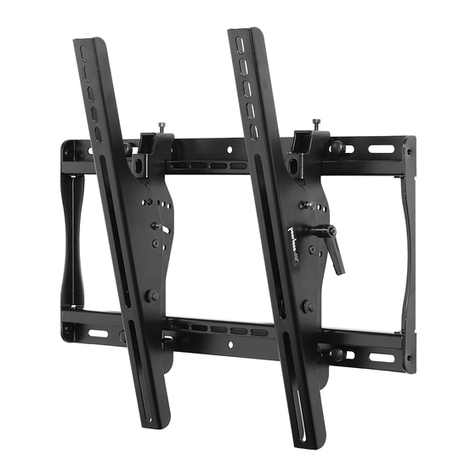
PEERLESS
PEERLESS Smartmount D-FPT-220 Installation and assembly
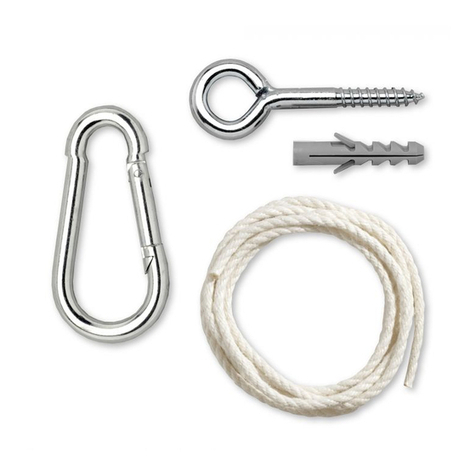
La Siesta
La Siesta SEGURO manual
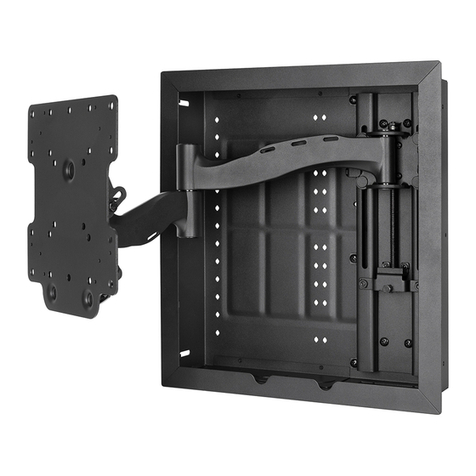
Strong
Strong VersaMount SM-VM-ART1-IW-M installation manual
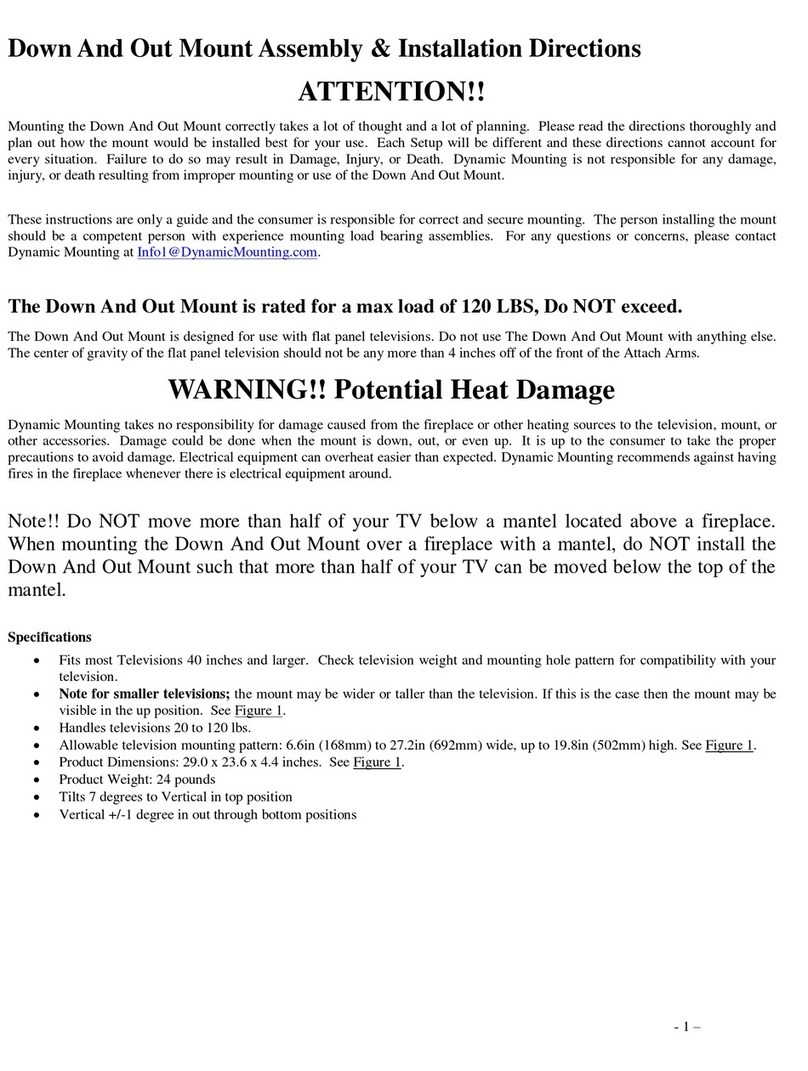
Dynamic Mounting
Dynamic Mounting Down and Out Mount Assembly & Installation Directions
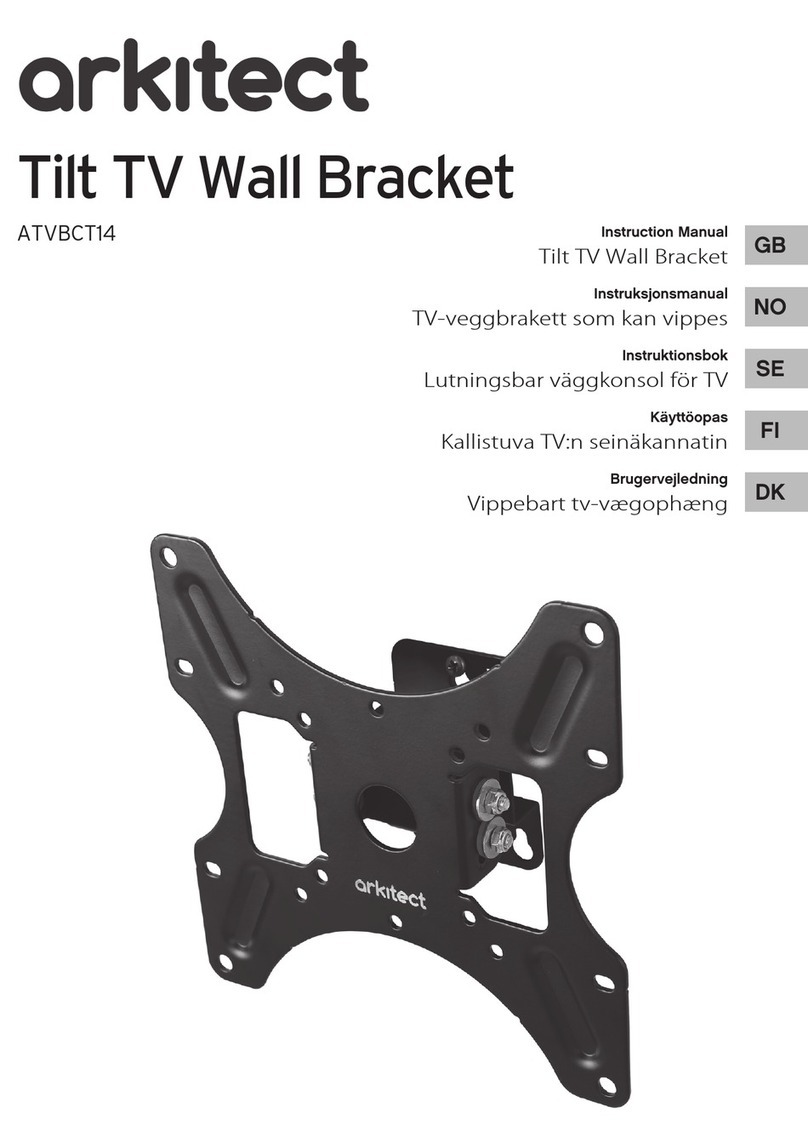
arkitect
arkitect ATVBCT14 instruction manual

Stell
Stell SHO 7530 manual


